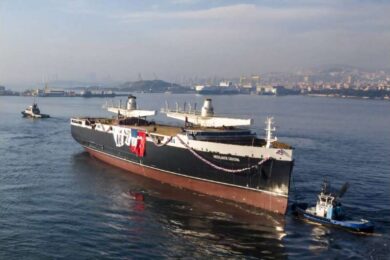Experience Polynesian flair at this unique celebration (published June 2013)
The summer of 2012 was London’s Olympic summer, but half a world away we were enjoying spectator sports of a different type. Who needs track and field when you can cheer for competitors in events like fruit basket races, stone lifting or coconut husking? At Tahiti’s annual Heiva Festival, tickets are cheap to free, audiences enthusiastic (everyone gets front row views) and at break time you can refresh yourself with coconut ice cream or passion fruit soda. Ah, the South Pacific!
 Each July, cruisers pack the marinas, mooring fields and anchorages in Tahiti’s protected lagoon, drawn as much by the festival as the alluring landscape and excellent ship services. Over the 130-year history of the Heiva, the festival eventually expanded from its roots in song and dance to showcase traditional sports as well. And so it was that we found ourselves cheering va’a (outrigger canoe) races against a stunning tropical backdrop, then checking the schedule for grimper au cocotier (coconut tree climbing), between inspecting the rigging and repairing the anchor windlass, that is.
Each July, cruisers pack the marinas, mooring fields and anchorages in Tahiti’s protected lagoon, drawn as much by the festival as the alluring landscape and excellent ship services. Over the 130-year history of the Heiva, the festival eventually expanded from its roots in song and dance to showcase traditional sports as well. And so it was that we found ourselves cheering va’a (outrigger canoe) races against a stunning tropical backdrop, then checking the schedule for grimper au cocotier (coconut tree climbing), between inspecting the rigging and repairing the anchor windlass, that is.
A Polynesian twist on a familiar event is the team javelin competition in which participants aim for a coconut at the top of a thirty-foot pole. The team with the most hits after seven hectic minutes wins, and the best athletes are immediately whisked aside for interviews on local television. Meanwhile, the crowd shifts excitedly over to the stone lifting venue, settling in the grass to watch competitors in several weight classes heave a 160-pound boulder to their shoulders in a race against the clock.
Another highlight is team coconut husking, where three-person teams speed-husk 150 coconuts. It’s a wild scene with the crowd cheering, coconut milk splashing, empty husks flying and chunks of white copra piling ever higher. The athletes in each of these events—men and women—are a sight themselves, dressed in colorful pareus (sarong-like wraps) and lush leafy headwear, with swirling tattoos on shoulders, legs, backs and even faces. For us, it was also a chance to witness the normally serene, unhurried Polynesians move into high gear.
 As exciting as the sports events are, the Heiva’s primary attractions are the dance and song competitions spread over eight evenings, each featuring two dance and two musical troops. Though the events are judged and winners take home hefty prize purses, it’s all about prestige. We were absolutely wowed by the spectacle of 100 synchronized dancers wearing gorgeous flower and shell-adorned costumes that sway with swinging hips to a blood-pumping drum beat. The open-air, seaside setting in Papeete’s grassy To’ata Place truly makes the evening one to remember. Sailors moored at the public docks are only a five-minute walk away from the arena and have front row views for the fireworks on France’s national holiday, July 14th.
As exciting as the sports events are, the Heiva’s primary attractions are the dance and song competitions spread over eight evenings, each featuring two dance and two musical troops. Though the events are judged and winners take home hefty prize purses, it’s all about prestige. We were absolutely wowed by the spectacle of 100 synchronized dancers wearing gorgeous flower and shell-adorned costumes that sway with swinging hips to a blood-pumping drum beat. The open-air, seaside setting in Papeete’s grassy To’ata Place truly makes the evening one to remember. Sailors moored at the public docks are only a five-minute walk away from the arena and have front row views for the fireworks on France’s national holiday, July 14th.
 Best of all, the Heiva remains a largely non-commercial, local affair despite its highly professional organization. Tahitians make up the majority of the audiences; there are no souvenirs for sale and no hawkers, just a lot of color, culture and fun. Tickets to the song and dance performances in the main arena go for $10 to $30, while the sports events are free. All in all, the Heiva is a unique, month-long celebration of tradition, folklore and artistry that should be on every Pacific cruiser’s calendar.
Best of all, the Heiva remains a largely non-commercial, local affair despite its highly professional organization. Tahitians make up the majority of the audiences; there are no souvenirs for sale and no hawkers, just a lot of color, culture and fun. Tickets to the song and dance performances in the main arena go for $10 to $30, while the sports events are free. All in all, the Heiva is a unique, month-long celebration of tradition, folklore and artistry that should be on every Pacific cruiser’s calendar.

















